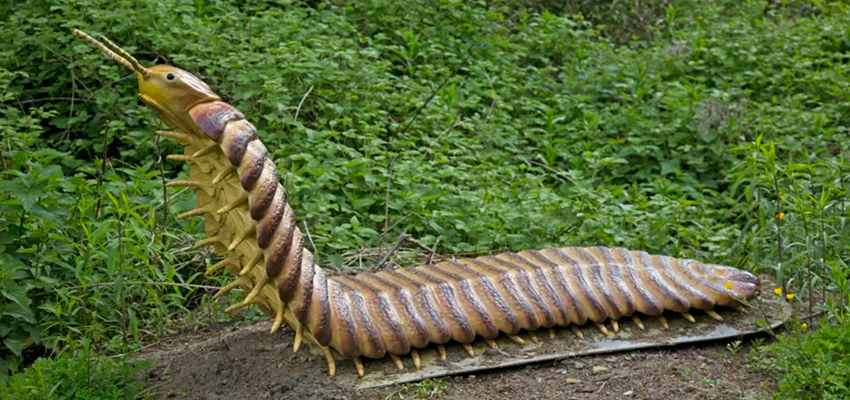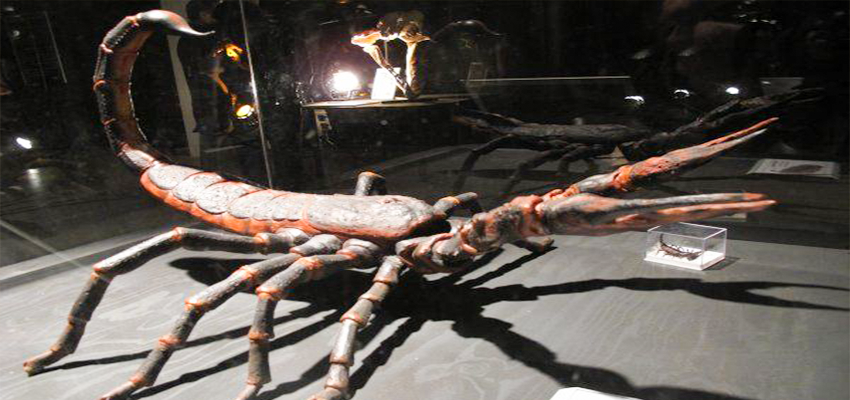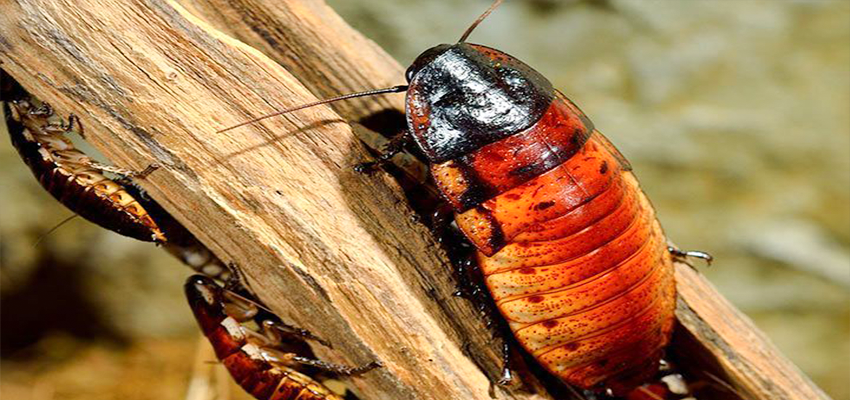What creatures roamed the earth long before humans ever set foot on it?
There were insects! Cases in point: some of the world’s earliest known life forms date back more than three billion years to the Early Cambrian Period, about halfway through the Precambrian Era. (The Precambrian is a time before the dinosaurs!)
Some of these prehistoric insect fossils have been discovered in North America, Europe, and Russia. And they’ve all left behind an astonishing record of early animal life–insects that may have laid eggs, hatched them into larvae, grown into adulthood, and maybe even mated!
Here are 20 prehistoric insects and bugs that you should know about:
1 Arthropleura

This is a genus of extinct millipede arthropod and would have inhabited parts of what is now North America and Scotland during the Carboniferous Period around 300 million years ago. The largest species of the genus are the largest land invertebrates of all time, according to current records, and would have faced very few predators, if any at all.
The creature could range from 0.3 to 2.3 meters with a width of up to 50 cm. Their exoskeleton consisted of 32 body segments, each with a pair of legs. The larger body segments were 48 cm wide. In opposition to earlier beliefs, the thing was not predatory, but herbivorous. Fossilized footprints recording the creature’s presence have been discovered in many places, appearing as rows of small parallel prints, giving the indication that the thing moved quickly across forest floors, making swerves to avoid trees, rocks and other obstacles.
2 Meganeuropsis

This Insect is a genus of extinct Griffon fly from the order Meganeuropsis Tara. It would have inhabited areas of North America and is the largest known insect ever recorded. It would have existed during the ought in skien age of the Permian period around 283.5 to 290.1 million years ago. The genus includes two species. There was more than one species of this creature. Think of having one of those lands in your drink.
First described in 1939, the mega neuropsis permiana was from Elmo, Kansas. It has an estimated wingspan of up to 28 inches. Discovered in 1940 in Oklahoma was the mega neuropsis Americana, in the Harvard Museum of Natural History is displayed a four wing fragment of eleven inches. A fully reconstructed wing estimated to be 12 inches, which makes it the largest wing ever to be discovered that wasn’t from a plane and gives the creature a resulting wingspan of 27 inches.
3 Titanomyrma Gigantea

This is an extinct ant species whose fossils were found in the Messel Pit near Darmstadt. It is the largest ant species of all time. Its queens grew larger than a hummingbird. Females were usually between 4 and 5.5 cm long. Males only had a size of 1 to 3 cm. However, the ants did not actually live during the Carboniferous Period, but appeared much later, about 47 million years ago.
4 Pulmonoscorpius Kirktonensis

This is a giant scorpion, but the species became extinct a long time ago. The literal translation of the name Pomona scorpius means lung scorpion. Its remains were found in Scotland, and the fossils suggest that this animal had a size of about 70 cm. Unfortunately, there is not much known about it, but it is believed to have lived about 330 million years ago.
5 Euphoberia Tracta

This is an extinct genus of millipedes, which lived during the late Carboniferous Period about 300 million years ago. Its fossils were found in Europe and North America. Unfortunately, there are still some ambiguities surrounding this species. Previously, it was considered to be a centipede or even a separate group. By now, it’s considered to be a millipede. Though the animal could reach a length of more than 30 cm.
6 Campanile Giganteum

This has been an exceptionally large sea snail. Today, the largest snail living on land is the giant African snail with 39.3 cm. However, with a size of more than 60 cm, sea gigantea was much larger still. There are even larger sea snails today, such as the Australian trumpet, whose shell can be as much as 90 cm long.
7 Primeval Cockroach (Urzeit Kakerlake)

A 300 million year old cockroach was found in a coal mine in Ohio. The cockroach had the size of a small mouse and was twice as big as most other finds. Shockingly, there are even larger cockroaches these days though, such as Macropanesthia rhinoceros, which can reach a length of up to 9 cm.
8 Giant Snails

In terms of giant size. Gastropods, the largest species today, are the African land snail. They can grow more than 7 inches long, with a shell diameter of about 4 inches. If that’s not big enough for you, consider this prehistoric specimen. It lived some 50 million years ago during the Eocene epoch. The appropriately named C. Giganteum was a marine gastropod that could grow some 2ft long lengthwise. It’s considered to be one of the biggest species of shelled gastropods that ever lived.
9 Ticks

Ticks are another species that we are all too familiar with today, but also bugged the dinosaurs tens of millions of years ago. A collector in Burma found a lump of amber in 2017 that contained one that appears to be entangled with a feather, and it’s teaching scientists about how they lived. The exact species of the animal that the feather came from isn’t yet known for certain. Either way, it would have been a great meal for the tick.
Another lump of amber had an identical type of parasite in it, but this one had only just finished a meal before it was caught in tree sap. This one was 8 times its original size, which means it was probably engorged with the blood of its victim. The finds were some of the first that proved parasitic insects plagued the animals of the Cretaceous period.
10 Cameroceras

Cameroceras, its upper body size can only be estimated, yet this is still regarded as one of the largest siliphopods that ever existed some 470 million years ago, and some sources claim it’s the largest one of all. Researchers say the animal may have reached 36 ft based on its shell remnants. It had tentacles growing from its cone-like shell that were used for seizing prey. A hard beak at the base of its tentacles would have cracked open the prey’s shell, or exoskeleton. They’re related to modern squids, cuttlefish and octopuses.
11 Fleas

If you’ve ever been around fleas, you’ll know how annoying they can be but imagine them being 10 times the size, with an equally big bite and thirst for blood, and that’s what dinosaurs had to face on a daily basis. Researchers who discovered these prehistoric monsters described their bite as being like a hypodermic needle going into the skin.
Because of their super-sized (0.039 to 0.13 inch) proboscis they used to feed, they were found as fossils in Mongolia, and while looking very much like soft bodied fleas, are thought to be the ancestors of a long extinct flea lineage. As well as having a vicious straw to drink blood through, they also had long claws that they could use to hold on tightly to the scales of their prey to ensure they could finish their meal before being shaken off.
12 Trilobites

These are marine arthropods that have scavenged in the oceans for hundreds of millions of years. By most accounts, they were among the most successful forms of early animal life. On average, they could reach about 3-6 inches but the largest known species is identified as IREX. That animal reached 28 inches long and 16 inches wide. With its armored shell, compound eyes and segmented body, it might have resembled today’s horseshoe crab, even though they’re not closely related. The closest living relatives to trilobites are animals like sea spiders, which is scary enough on their own.
13 Pambdelurion

Paleontologists say its fossils have been found in China and date back some 520 million years. They belong to a class of wormlike creatures distinguished by their mouths filled with circulates of plates and choppers. Some have compared it to the Sarlacc beast from Star Wars but this critter would have been a real life nightmare. Its head was lined with large spikes, behind which was its mouth. The mouth had 3 layers of teeth and plates that protruded out in a pyramid like shape. Prey was spared by the animal’s spikes, while the mouth sprang open to feed at around 2ft long.
14 Platypus of Crabs

Scientists discovered a new species of crab in 2019 that was unlike anything they’d ever seen. Dating back some 95 million years, the prehistoric animal had a shrimp-like mouth, the eyes of a lava, claws like a crab, and a lobster’s carapace. Its bizarre anatomical mashup earned the nickname the platypus of crabs. Due to its unusual legs, scientists think it was probably a water dweller and spent more time swimming than crawling on the ground. Another major departure from normal crab features was this animal’s size.
15 Scorpion Spiders

Around 100 million years ago, an arachnid existed that could nearly pass as a spider and scorpion hybrid. Paleobiologists found the creature’s remains preserved in Burmese amber in Myanmar. The specimen had a body length of 2.5 mm, while its tail measured about 3 mm. Their whip-like tails are similar to those of the present day whip scorpion, which are not true scorpions either but these ancient, mysterious arachnids did possess several traits typical of true spiders, including spinnerets to create silk.
So these newly unearthed animals could be an example of a Lazarus toxin with no fossil record, or they might have belonged to an extinct group that shared some similar origins as spiders. In any case, the arachnids could prove that spider-like creatures with tails existed alongside true spiders some 200 million years ago.
16 Shrimp

Its official name is Anomalocaris, but it’s likely better known as the abnormal shrimp. It lived more than 500 million years ago and was first described in 1892. Back in its day, there were evidently a lot of these critters swimming in the world’s oceans. That’s because their fossils have been found widely distributed all around the globe. It’s thought to have been a ferocious predator, mainly feeding on trilobites or extinct marine anthropods. Anomalocaris would have made for a truly giant shrimp.
17 Hallucigenia

This animal is known from fossils found in China and Canada. It’s odd name is a reference to its hallucinatory appearance. They were tubular creatures, about 1.4 inches long, with up to 8 pairs of legs that each had a pair of claws. Another 3 sets of pincers were located behind their legs. They had no sensory organs like eyes or ears, and while they were most often considered to be a type of worm, some experts think they’re more like anthropods.
18 Mosquitoes

Mosquitoes are one of the largest causes of human fatalities throughout the world because of the diseases that they carry, with some estimates suggesting as many as 4000 people die each year because of malaria alone. Normally the size of mosquitos is around 19.5 cm but the largest prehistoric size measured 30 cm. Their annoyance isn’t just a human issue and a discovery announced in early 2019 suggests that their impact hasn’t changed much in 100 million years. Even if the species have, they have been equally annoying to all species with blood for millions of years found in Amber in Myanmar, researchers have identified a new type of anaphylan which is the family of mosquitoes that carry malaria.
At the time it was caught in tree sap it would have been living in a tropical forest surrounded by velociraptors and T-rexes and would have fed on birds, small mammals and reptiles of all sizes. They definitely would have been bothering the dinosaurs in the same way they do us. And researchers are now looking at whether they could have been victors for disease spreading. Some believe the true reason for the extinction of the dinosaurs was a plague or an illegal illness and it’s quite possible that mosquitoes were the ones responsible for spreading it.
19 Manipulator

While we might assume a prehistoric cockroach was a huge version of today’s insect, such is not the case here but even though the manipulator was a mere 4.5 mm long, it would still give you a skier. It had a freely rotating head, an elongated neck, and unusually long legs that were used for chasing prey or ambushing it. Experts say it probably hunted at night as it skittered around nearly 100 million years ago. Even though it’s identified as a cockroach, its closest living relative today is the praying mantis.
20 Monster Sea Scorpions

One might quibble that Jaekelopterus Rhenaniae wasn’t really a sea scorpion, because it probably lived in freshwater environments but there’s no arguing about how frightening this beast would have been alive some 390 million years ago. Jay Rhenaniae measured some 8.5ft and is the largest Anthropod yet to be discovered that is double the height of some people. It possessed heavy, robust pincers more than 18 inches long and was probably an apex predator even though they’re the largest anthropods, these animals had a lightweight build so they weren’t necessarily the heaviest of the lot but they were extremely agile and highly maneuverable.
References:
- Bugs Before Time: Prehistoric Insects and Their Relatives By Cathy Camper
- Prehistoric Bugs: Trapped in Amber By Laurie Steding





